1993 BUICK CENTURY wheel
[x] Cancel search: wheelPage 264 of 324
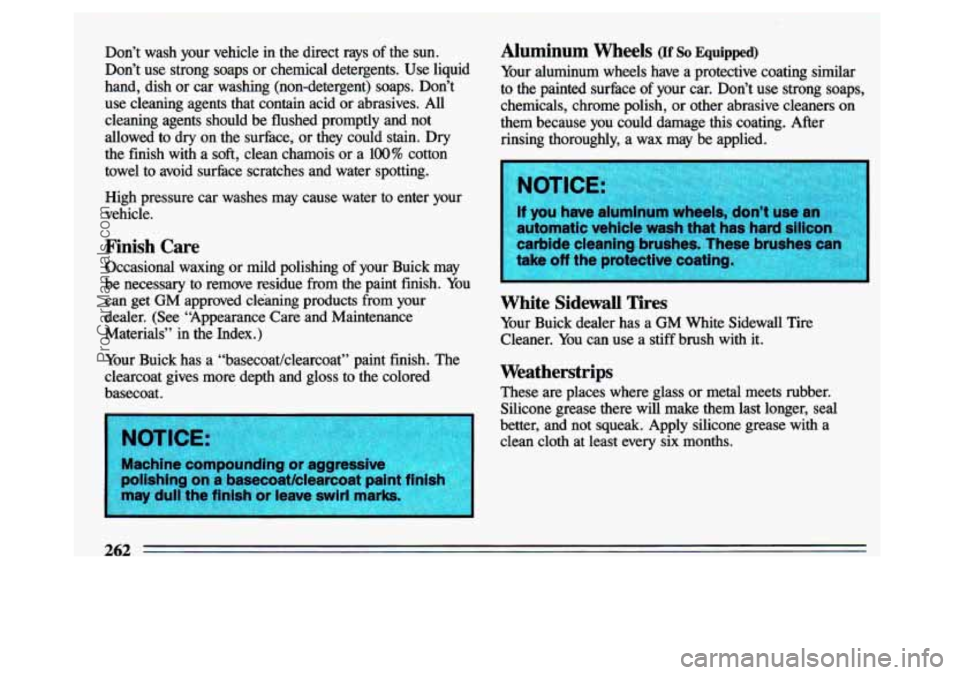
Don’t wash your vehicle in the direct rays of the sun.
Don’t use strong soaps or chemical detergents. Use liquid
hand, dish or car washing (non-detergent) soaps. Don’t
use cleaning agents that contain acid or abrasives. All
cleaning agents should be flushed promptly and not
allowed to dry on the surface, or they could stain. Dry
the finish with a
soft, clean chamois or a 100% cotton
towel to avoid surfhce scratches and water spotting.
High pressure car washes may cause water to enter your
vehicle.
Finish Care
Occasional waxing or mild polishing of your Buick may
be necessary to remove residue from the paint finish. You
can get
GM approved cleaning products from your
dealer. (See “Appearance Care and Maintenance Materials” in the Index.)
Your Buick has a “basecoat/clearcoat” paint finish. The
clearcoat gives more depth and gloss to the colored
basecoat.
Aluminum Wheels (If SO Equipped)
Your aluminum wheels have a protective coating similar
to the painted surface of your car. Don’t use strong soaps,
chemicals, chrome polish, or other abrasive cleaners on
them because you could damage this coating. After
rinsing thoroughly, a wax may be applied.
White Sidewall Tires
Your Buick dealer has a GM White Sidewall Tire
Cleaner. You can use a stiff brush with it.
Weatherstrips
These are places where glass or metal meets rubber.
Silicone grease there will make them last longer, seal
better, and not squeak. Apply silicone grease with a
clean cloth at least every six months.
262
ProCarManuals.com
Page 267 of 324

Vehicle Identification Number 0
1
0
SAMPLE4UXPM072675 (cml
This is the legal identifier. for your Buick. It appears on a
plate in the front comer
of the instrument panel, on the
driver’s side.
You can see it if you look through the
windshield from outside, your vehicle. The VIN also
appears on the Vehicle Certification and Service
Parts
labels and the certificates of title and registration.
Engine Identification
The eighth character in your VIN is the engme code for
your
GM engine. This code will help you identify your
engine, specifications, and replacement parts
in this
section.
Service Parts Identification Label
You’ll find this label on your spare tire cover in the coupe
or sedan.
In the wagon, you’ll find the label on the wheel
well (remove the spare tire cover to expose the wheel
well). It’s very helpful
if you ever need to order parts.. On
this label is:
Your VIN.
Its model designation.
Paint information.
A list of all production options and special equipment.
Be sure that
this label is not. removed from. the vehicle.
Add-on Electrical Equipment
265
ProCarManuals.com
Page 271 of 324

Century Dimensions
Inches unless otherwise noted .
Overall: COUPE SEDAN WAGON
Length ................
. Width .................
Height ................
Wheelbase .............
Front Tread ............
Rear Tread .............
Interior Front:
Leg Room
.............
Head Room ............
Shoulder Room .........
Hip Room ..............
Interior Rear:
Leg Room .............
Head Room ............
Shoulder Room .........
Hip Room ..............
Tzvnk Capacity-Cubic Feet
Number of Passengers:
Front .................
Rear ..................
Rear-Facing Third Seat ...
Base Curb Weight--Po unds 189.1
69.4 53.7
104.9 58.7
56.7
42.1 38.6
55.8
50.2
35.9
38.3
57
. 0
53.6
16.2
3
3
.
2862 189.1
69.4
54.2
104.9 58.7
56.7 190.9
69.4
54.2
104.9 58.7
56.7
42.1 42.1
38.6 38.6
55.9 55.9
50.0 50.0
35.9
38.3
56.0
54.3
16.2
3
3
.
2914 34.8
38.9
56.0
54.3
41.6
3
3
2
3054
Replacement Bulbs
APPLICATION NUMBER
Exterior
Headlight High Beam
........................
Low Beam .........................
ParW Turn ...........................
Side Marker ....... .................
Backup .............................
High Level Stop (w/o luggage carrier) .....
High Level Stop (w/luggage carrier) .......
License .............................
Side Marker .........................
Tail/Stop ............................
Tail/Stop/Turn .........................
Underhood ..........................
9005
9006
2057 194
1156
1141
577 194
194
194
2057
561
Interior
Ashtray ............................. 194
Door Courtesy
....................... 214-2
Dome
.............................. 211-2
Front Reading
........................ 906
Glove Box ............................ 194
Map
............................... 168
Rear Dome (Wagon)
................... 211-2
Trunk
.............................. 1003
Vanity Mirror ........................ 124
269
.
ProCarManuals.com
Page 282 of 324
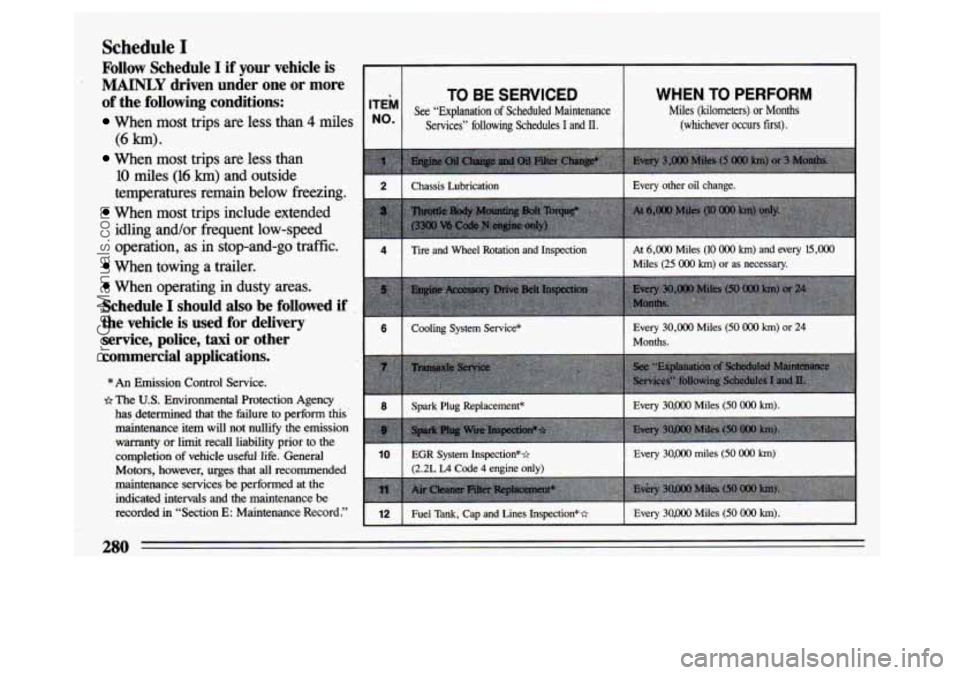
Schedule I
Follow Schedule I if your vehicle is
MAINLY driven under one or more
of the following conditions:
When most trips are less than 4 miles
When most trips are less than
10 miles (16 km) and outside
temperatures remain below freezing.
When most trips include extended
idling and/or frequent low-speed
operation, as
in stop-and-go’ traffic.
(6 km).
When towing a trailer.
When operating in dusty areas.
Schedule I should also be followed if
the vehicle
is used for delivery
service, p?lice,
taxi or other
commercial applications.
* An Emission Control Service.
z2T The U.S. Environmental Protection Agency
has.determined that the failure to perform this
maintenance item will not nullify the emission
wamty
or limit recall liability prior to the
completion of vehicle useful life. General
Motors, however, urges that all recommended
maintenance services
be performed at the
indicated intervals and the maintenance be
recorded in “Section E: Maintenance Record.”
ITEM
NO.
TO BE SERVICED WHEN TO PERFORM
See “Explanation of Scheduled Maintenance Miles (kilometers) or Months
Services” following Schedules
I and D[. (whichever occurs first).
2 I Chassis Lubrication I Every other oil change.
Tire
and Wheel Rotation and Inspection At 6,000 Miles (10 000 km) and every 15,000
Miles (25 000 km) or as necessary. I
61
Cooling System Service* Every 30,000 Miles (50 O00 km) or 24
Months. I
8 I Spark
Plug Replacement* I Every 30,000 Miles (50 000 km). I
EGR System Inspection** Every 30,000 miles (50 OOO km)
(2.2L LA Code 4 engine only)
12 I Fuel Tank, Cap and Lines Inspection** I Every 30,000 Miles (50 OOO km). I
280
ProCarManuals.com
Page 284 of 324
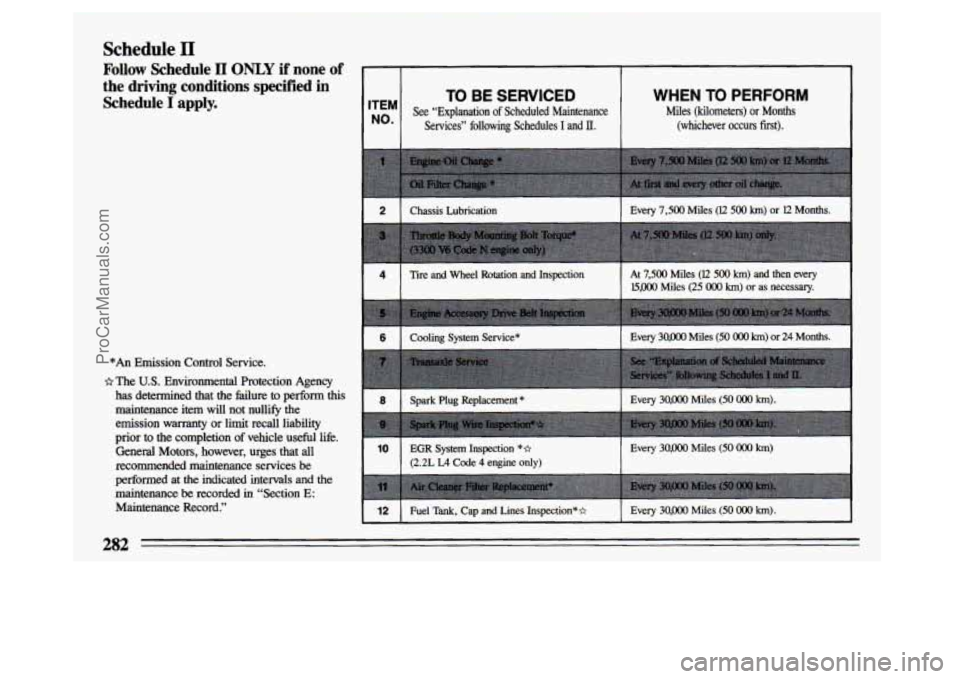
Schedule 11
Follow Schedule II ONLY if none of
the driving conditions specified in Schedule
I apply.
*An Emission Control Service.
I% The U.S. Environmental Protection Agency
has determined that the failure
to perform this
maintenance item will not nullify the
emission warranty
or limit recall liability
prior to the completion of vehicle useful life.
General
Motors, however, urges that all
recommended maintenance services be
performed at the indicated intervals
and the
maintenance be recorded in “Section E:
Maintenance Record.”
TO BE SERVICED ITEM
No’ See “Explanation of Scheduled Maintenance
Services” following Schedules
I and II.
WHEN TO PERFORM
Miles (kilometers) or Months
(whichever
occurs first).
4l
Tire and Wheel Rotation and Inspection
Cooling
System Service* Every 30,000 Miles (50 OOO km) or 24
Every 30,000 Miles (50 000 km).
lo I
Every 30,000 Miles (50 OOO km)
12 I Fuel Tank, Cap and Lines Inspection** I Every 30,000 Miles (50 000 km).
282
ProCarManuals.com
Page 286 of 324
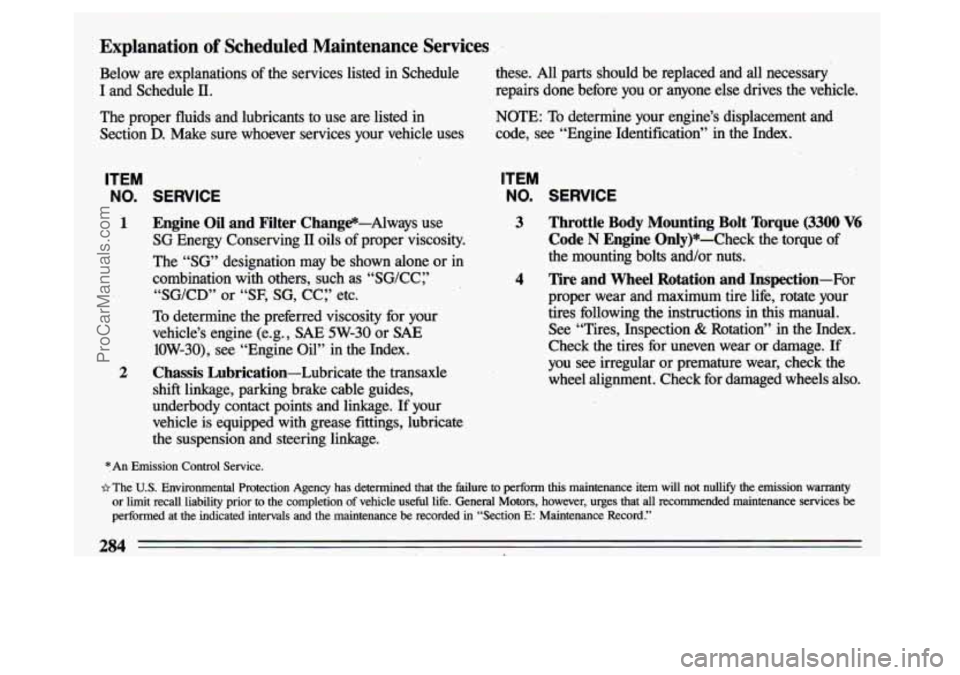
Explanation of Scheduled Maintenance Services
Below are explanations of the services listed in Schedule
I and Schedule II.
The proper fluids and lubricants to use are listed in
Section
D. Make sure whoever services your vehicle uses
ITEM
NO. SERVICE
1 Engine Oil and Filter Change-Always use
SG Energy Conserving 11 oils of proper viscosity.
The “SG” designation may be shown alone or in
combination with others, such as ‘‘SG/CC:’
“SG/CD” or “SF, SG, CC:’ etc.
To determine the preferred viscosity for your
vehicle’s engine (e.g., SAE
5W-30 or SAE
10W-30), see “Engine Oil” in the Index.
2 Chassis Lubrication-Lubricate the transaxle
shift linkage, parking brake cable guides,
underbody contact points and linkage. If your
vehicle is equipped with grease fittings, lubricate
the suspension and steering linkage. these. All parts should be replaced and all necessary
repairs done before you or anyone else drives the vehicle.
NOTE: To determine your engine’s displacement and
code, see “Engine Identification” in the Index.
ITEM
NO. SERVICE
3 Throttle Body Mounting Bolt Torque (3300 V6
Code N Engine Only)*-Check the,torque of
the mounting bolts and/or nuts.
4 Tire and Wheel Rotation and Inspection-For
proper wear and maximum tire life, rotate your
tires following the instructions
in this manual.
See “Tires, Inspection & Rotation” in the Index.
Check the tires for uneven wear or damage. If
you see irregular or premature wear, check the
wheel alignment. Check for damaged wheels also.’
*An Emission Control Service.
~2 The U.S. Environmental Protection Agency has determined that the failure to perform this maintenance item will not nullify the.emission warranty
or limit recall liability prior
to the completion of vehicle useful life. General Motors, however, urges that all recommended maintenance services be
performed at the indicated intervals and the maintenance be recorded in “Section E: Maintenance Record.”
284
ProCarManuals.com
Page 292 of 324
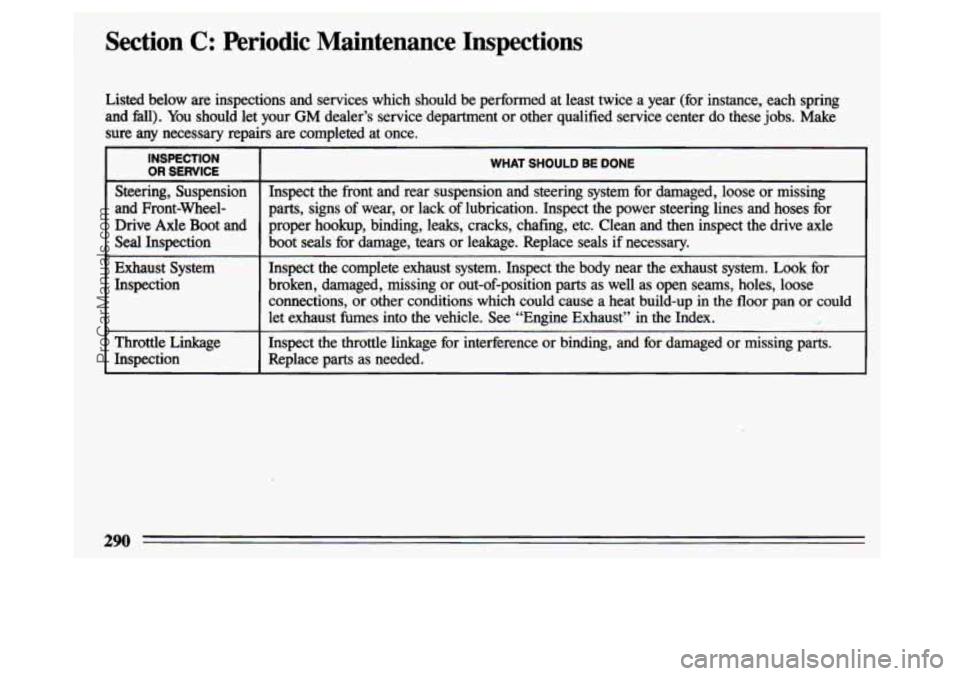
Section C: Periodic Maintenance Inspections
Listed below are inspections and services which should be performed at least\
twice a year (for instance, each spring
and M1). You should let your
GM dealer’s service department or other qualified service center do these jobs. Make
sure any necessary repairs are completed at once.
INSPECTION
OR SERVICE
Steering, Suspension
and Front-Wheel- Drive Axle Boot and
Seal Inspection
Exhaust System
Inspection
~~~~ ~~
Throttle Linkage
Inspection
WHAT SHOULD BE DONE
Inspect the front and rear suspension and steering system for \
damaged, loose or missing
parts, signs of wear, or lack
of lubrication. Inspect the power steering lines and hoses for
proper hookup, binding, leaks, cracks, chafing, etc. Clean and \
then inspect the drive axle
boot
seals for damage, tears or leakage. Replace seals if necessary.
Inspect the complete exhaust system. Inspect the body near the \
exhaust system. Look for
broken, damaged, missing or out-of-position parts as well as op\
en seams, holes, loose
connections, or other conditions which could cause a heat build\
-up in the
floor pan or could
let exhaust fumes into the vehicle. See “Engine Exhaust”
in the Index.
Inspect the throttle linkage for interference or binding, and f\
or damaged or missing parts.
Replace parts as needed.
290
ProCarManuals.com
Page 293 of 324
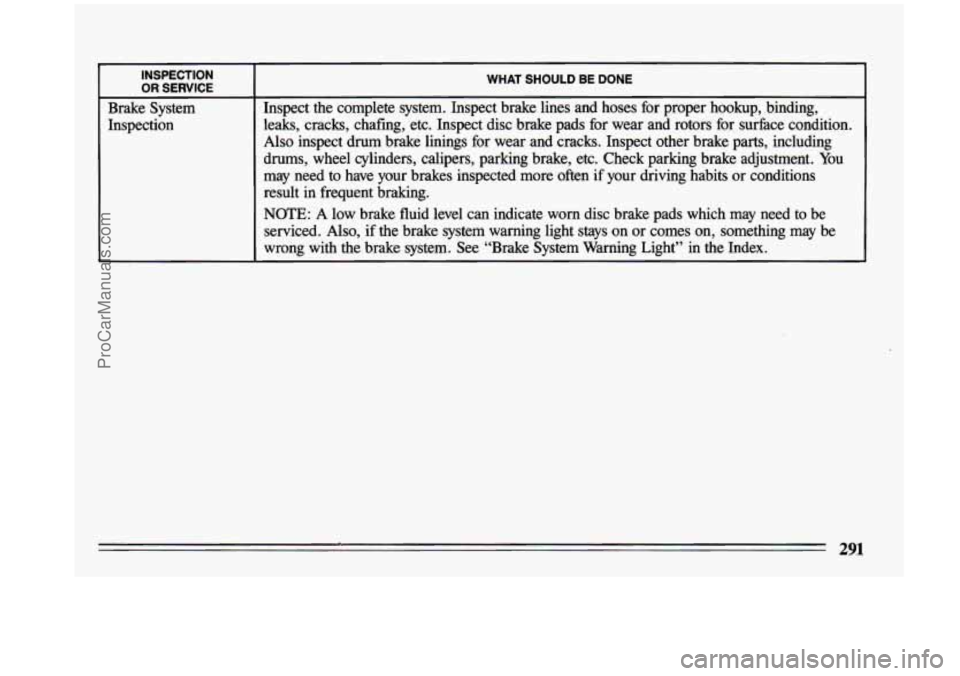
~ ~~ ~ ~ ~~~ INSPECTION
OR SERVICE
Brake System
Inspection
WHAT SHOULD BE DONE
Inspect the complete system. Inspect brake lines and hoses for \
proper hookup, binding,
leaks, cracks, chafing, etc. Inspect disc brake pads for wear \
and rotors for surface condition.
Also inspect drum brake linings for wear and cracks. Inspect o\
ther brake parts, including
drums,
wheel cylinders, calipers, parking brake, etc. Check parking bra\
ke adjustment. You
may need to have your brakes inspected more often
if your driving habits or conditions
result
in frequent braking.
NOTE: A low brake fluid level can indicate worn disc brake pads which may need to be
serviced.
Also, if the brake system warning light stays on or comes on, something may be
wrong with the brake system. See “Brake System Warning Light\
” in the Index.
ProCarManuals.com